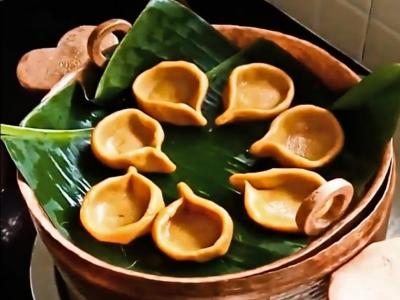Deep Amavasya 2024: Date, Time, Puja Vidhi and Significance of Lighting Dough Lamps for Ancestors
By Lokmat English Desk | Updated: August 3, 2024 16:58 IST2024-08-03T16:43:48+5:302024-08-03T16:58:48+5:30
This year, Ashadha Amavasya, also known as Deep Amavasya or The Arrival of Lights, falls on August 4. On ...

Deep Amavasya 2024: Date, Time, Puja Vidhi and Significance of Lighting Dough Lamps for Ancestors
This year, Ashadha Amavasya, also known as Deep Amavasya or The Arrival of Lights, falls on August 4. On this day, devotees clean and light lamps in the Dev house, placing them on the leaf in the evening after removing rangoli. The ritual also includes displaying lights of kanaka during the puja, a key aspect of this tradition. However, many people are curious whether these lamps are intended for deep worship or for honoring ancestors. Here, we explore the significance and science behind this practice.
This year, Deep Amavasya will be observed in Maharashtra on August 4. Following this, the month of Shravan will commence on August 5. The new moon phase will start at 3:50 PM on August 3 and conclude at 4:42 PM on August 4.
On Amavasya, ancestors are honored, and charitable acts are performed. Each new moon has its own significance, and Ashadha Amavasya is particularly noted for the worship of lamps. This ritual prepares devotees for the upcoming Shravan month. During this time, a lamp made of flour or millet is lit in the south direction. This lamp serves dual purposes: it is used for both deep puja and the worship of ancestors. Additionally, the lamp attracts organisms like ants, which consume the particles around it, symbolizing an indirect form of food donation.
The lamp used for Deep Amavasya is prepared in jaggery water, making it so delicious that it is often eaten as a snack wrapped in leaves. While people might forget the specifics of festivals, the path of flavor is something they remember well. These lamps become a hallmark of the festival, serving as a yearly reminder of the tradition.
Creating these lamps is both easy and cost-effective, making it accessible for people from ordinary households. When enjoyed with plain ghee, their taste is enhanced. Given the fondness for these lamps, it is believed that ancestors and micro-organisms are also satisfied by consuming them. Thus, the lamps of Kanaka play a significant role in the observance of Deep Amavasya.
How to Make Traditional Deep Amavasya Lamps
Ingredients:
Jaggery
Wheat flour
Salt
Ghee
Oil or additional ghee for greasing
Instructions:
Prepare the Jaggery Mixture:
Heat enough water to dissolve a quarter bowl of jaggery, melting it completely.
Prepare the Dough:
In a bowl, mix wheat flour with a pinch of salt and two teaspoons of ghee. Gradually add the jaggery water to the flour mixture until it forms a dough.
Shape the Lamps:
Form the dough into small balls and shape them into lamps. Prepare enough for distribution to the needy.
Grease and Cook:
Grease a sieve or an idli vessel with oil or ghee. Place the shaped lamps in it. Fill a large bowl with water, set the sieve on top of the water, and cover with a plate. Alternatively, you can use an idli steamer for this purpose.
Steam the Lamps:
Cook the lamps for about 20 minutes. Once done, turn off the gas and let the lamps cool slightly. Add a drizzle of plain ghee on top before serving.